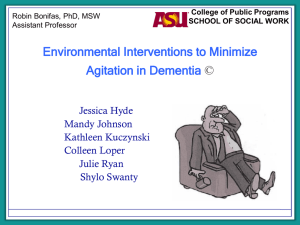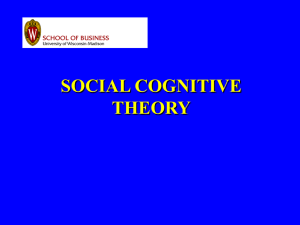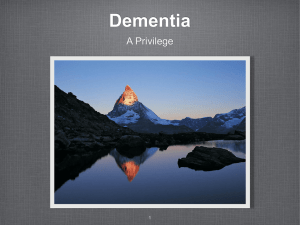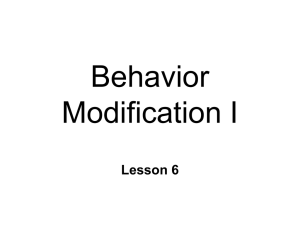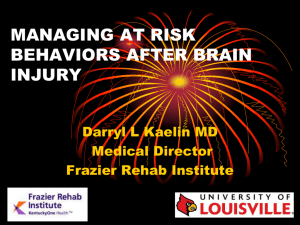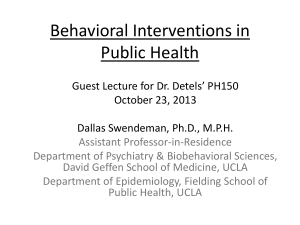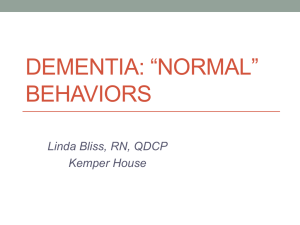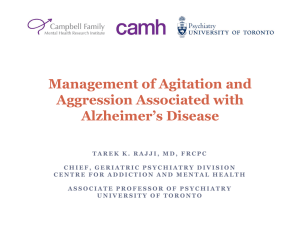Managing Behavorial Symptoms of Dementia in a Person Centered
advertisement
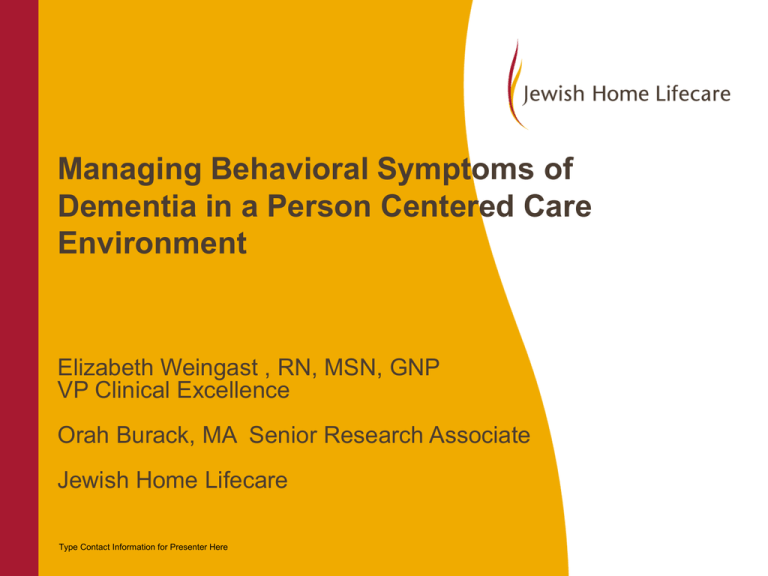
Managing Behavioral Symptoms of Dementia in a Person Centered Care Environment Elizabeth Weingast , RN, MSN, GNP VP Clinical Excellence Orah Burack, MA Senior Research Associate Jewish Home Lifecare Type Contact Information for Presenter Here What is Dementia? Dementia is a general term for a decline in mental ability severe enough to interfere with daily life. Alzheimer’s 60-80% of dementias Vascular Dementia Dementia related to other diseases – Parkinson’s, Huntington’s Reversible causes – thyroid disease, vitamin B12 deficiency 2 While symptoms of dementia can vary greatly, at least two of the following core mental functions must be significantly impaired to be considered dementia: ·Memory ·Communication and language ·Ability to focus and pay attention ·Reasoning and judgment ·Visual perception Stages of Alzheimer’s Dementia Staged from 1 – 7 , no impairment to very severe cognitive decline Stage 3 “mild cognitive decline” Stage 6 – common access point to nursing home care •Stage 6: Severe cognitive decline (Moderately severe or mid-stage Alzheimer's disease) •Memory continues to worsen, personality changes may take place and individuals need extensive help with daily activities. At this stage, individuals may: •Lose awareness of recent experiences as well as of their surroundings •Remember their own name but have difficulty with their personal history •Distinguish familiar and unfamiliar faces but have trouble remembering the name of a spouse or caregiver 5 •Need help dressing properly and may, without supervision, make mistakes such as putting pajamas over daytime clothes or shoes on the wrong feet •Experience major changes in sleep patterns — sleeping during the day and becoming restless at night •Need help handling details of toileting Have increasingly frequent trouble controlling their bladder or bowels •Experience major personality and behavioral changes, including suspiciousness and delusions (such as believing that their caregiver is an impostor)or compulsive, repetitive behavior like hand-wringing or tissue shredding •Tend to wander or become lost 6 CMS – approach to behavior management in nursing homes Rise in use of antipsychotics for control of behaviors 23-25% of nursing home residents prescribed antipsychotics Often without diagnosis of psychosis Atypical antipsychotics (Seroquel, Risperidal, Zyprexa) carry a black box warning for people with dementia due to increased risk of cardiovascular events, including stroke or heart attack. No research supporting us of these medications for behavioral symptoms of dementia Goal to reduce use by 15% over six months in 2012 7 CMS approach – Education and Survey Focus •Person Centered Care •Quality and Quantity of Staff •Thorough Evaluation of New or Worsening Behaviors •Individualized Approaches to Care •Critical Thinking Related to Antipsychotic Drug Use •Engagement of Resident and/or Representatives in Decision Making 8 Person Centered Care Greenhouse Model 9 Comfort First Understanding Behavior as Communication 10 Programming and Training Modeling Communication Personal Care approaches Meaningful activities Special Care Units – inconclusive outcomes 11 Music and Memory Everyone benefits from a calmer, more supportive social environment. Staff regain valuable time previously lost to behavior management issues. There is growing evidence that a personalized music program gives professionals one more tool in their effort to reduce reliance on antipsychotic medications 12 http://www.youtube.com/watch?v=5FWn4JB2YLU&list=UUWSW0V yPUvG8dfJc9VtFQRg Alive Inside 13 INTRODUCTION Distressing behavioral symptoms often associated with dementia are not uncommon in the LTC setting. The MDS 3.0 categorizes these symptoms as: physical behavioral symptoms directed toward others (e.g., pushing, hitting) verbal behavioral symptoms directed towards others (e.g., screaming, cursing at others) behavioral symptoms not directed toward others (e.g., hurting self, pacing, making disruptive sounds) 14 INTRODUCTION CON’T Potential antecedents of these symptoms illness distress pain unrecognized need caregiving actions not understood by the elder Culture change with its “person-centered approach to care” provides a potential non-pharmacological approach to reducing these symptoms 15 INTRODUCTION CON’T Different behavioral symptoms may have different causes; thus, interventions could address those causes forceful behaviors such as kicking may be related to caregiving assistance (e.g., bathing or feeding); elder may not understand or find frightening physical agitation (e.g., pacing) may be due to an inadequate amount of stimulation in the environment verbal agitation may be related to discomfort, pain, or depression 16 CULTURE CHANGE INTERVENTION Community Coordinators Education Organizational and Community Structure Changes Meaningful Activities and Resident Choice Family Involvement Reduced Floating Consistent Staffing Environmental Changes 17 RESEARCH QUESTION What is the impact of a culture change intervention on the following categories of behavioral symptoms: forceful behaviors physical agitation verbal agitation Hypothesis: elders receiving culture change intervention compared to controls will have reduced behavioral symptoms (can be addressed by a person-centered approach to care ) 18 STUDY DESIGN 13 long term care comm across 3 campuses 7 Culture change pilot communities 6 Comparison communities Longitudinal study - 2 time points Time 1 – 2003 Time 2 – 2005 19 COHEN MANSFIELD AGITATION INVENTORY (CMAI) 29 behavioral symptoms CNA rated frequency with which the elder manifested each behavior during past two weeks each behavior rated on a 7 point scale (1)“Never” (2) “Less than once a week but still occurring” (3) “Once or twice a week” (4) “Several times a week” (5) “Once or twice a day” (6) “Several times a day” (7) “A few times an hour”. 20 CMAI – FORCEFUL BEHAVIORS (12 ITEMS) Hitting, Kicking, Scratching Biting, Pushing, Grabbing Throwing things, Cursing & Verbal Aggression Spitting, Tearing things or Destroying Property Hurting self or others Screaming 21 CMAI – PHYSICAL AGITATION (6 ITEMS) pacing and aimless wandering attempting to exit area inappropriately general restlessness inappropriate dressing and disrobing handling things inappropriately repetitious behaviors 22 CMAI – VERBAL AGITATION (4 ITEMS) Complaining Constant requests for attention or help Repetitive sentences or questions Expressing a negative attitude 23 MEASURES Behavioral Symptoms – Cohen Mansfield Agitation Inventory (CMAI) – captures forceful behaviors, physical agitation, and verbal agitation (CNA interviews) Cognitive Impairment – MDS2.0 Cognitive Performance Scale (high score indicates greater severity) ADL Impairment – 4 ADL items from MDS2.0 (high score indicates greater dependence) Number of Diagnoses - use MDS2.0 med record data 24 STUDY PARTICIPANTS N = 101 65 (64%) female 36 (36%) male 58% White; 28% Black, and 14% Hispanic Age range = 63 to 105 years (M=83.65, SD=9.29). Length of stay on communities; Range= 4 months to 14 years (M=34 months, SD=29 months) 25 ANALYSIS PLAN • 2 (Group) X 2 (Time) ANOVA* Time 1 Time 2 Culture Change Comparison 26 RESULTS 27 PREVALENCE OF BEHAVIORAL SYMPTOMS All Time 1 Time 2 Forceful Behaviors Physical Agitation Verbal Agitation 49% 39% 52% 57% 44% 57% Comparison Forceful Behaviors Physical Agitation 44% 32% 61% 37% Verbally Agitation Culture Change Forceful Behaviors 36% 56% 54% 52% Physical Agitation Verbal Agitation 45% 68% 51% 58% 28 Forceful Behaviors: Adjusted mean scores. Significant Interaction. F(1,92)=5.40, p=.022. 29 Physical Agitation: Adjusted mean scores. Significant Interaction. F(1,89)=6.34, p=.014 30 Verbal Agitation: Adjusted mean scores. Interaction Approaching Significance. F(1,86)=3.62, p=.061 31 Summary forceful behaviors and physical agitation increased over time on comparison communities, but not on culture change communities implementing a culture change model can be an effective non-pharmacological approach to ameliorating behavioral symptoms future studies should examine changes in pharmacological approaches when implementing culture change. unique study feature - the inclusion of elders with wide ranging cognitive abilities, ranging from no cognitive impairment to more severe impairment 32 Possible Links between Culture Change & Behavioral Symptoms physical agitation (related to inadequate stimulation in environment) may have been affected by increasing selected meaningful activities for elders forceful behavior (resistance to care) may have been affected by increasing choice over when to participate in activities, environmental changes (e.g. calmer atmosphere), more consistent staffing verbal agitation (related to depressed affect) showed a trend; may be related to quality of relationships; may need to further enhance these culture change elements 33 Handouts – Questions to post to facility leadership Are programs in place to ensure best practice in care for residents with behavioral symptoms of dementia? 34

